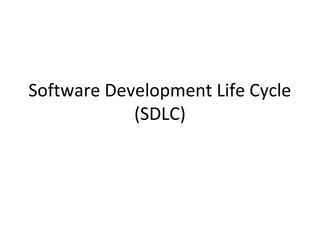Sdlc
- 1. Software Development Life Cycle (SDLC)
- 2. SDLC Model A framework that describes the activities performed at each stage of a software development project.
- 3. Waterfall Model âĒ Requirements â defines needed information, function, behavior, performance and interfaces. âĒ Design â data structures, software architecture, interface representations, algorithmic details. âĒ Implementation â source code, database, user documentation, testing.
- 4. Waterfall Strengths âĒ Easy to understand, easy to use âĒ Provides structure to inexperienced staff âĒ Milestones are well understood âĒ Sets requirements stability âĒ Good for management control (plan, staff, track) âĒ Works well when quality is more important than cost or schedule
- 5. Waterfall Deficiencies âĒ All requirements must be known upfront âĒ Deliverables created for each phase are considered frozen â inhibits flexibility âĒ Can give a false impression of progress âĒ Does not reflect problem-solving nature of software development â iterations of phases âĒ Integration is one big bang at the end âĒ Little opportunity for customer to preview the system (until it may be too late)
- 6. Structured Evolutionary Prototyping Steps âĒ A preliminary project plan is developed âĒ An partial high-level paper model is created âĒ The model is source for a partial requirements specification âĒ A prototype is built with basic and critical attributes âĒ The designer builds â the database â user interface â algorithmic functions âĒ The designer demonstrates the prototype, the user evaluates for problems and suggests improvements. âĒ This loop continues until the user is satisfied
- 7. Structured Evolutionary Prototyping Strengths âĒ Customers can âseeâ the system requirements as they are being gathered âĒ Developers learn from customers âĒ A more accurate end product âĒ Unexpected requirements accommodated âĒ Allows for flexible design and development âĒ Steady, visible signs of progress produced âĒ Interaction with the prototype stimulates awareness of additional needed functionality
- 8. Structured Evolutionary Prototyping Weaknesses âĒ Tendency to abandon structured program development for âcode-and-fixâ development âĒ Bad reputation for âquick-and-dirtyâ methods âĒ Overall maintainability may be overlooked âĒ The customer may want the prototype delivered. âĒ Process may continue forever (scope creep)
- 9. When to use the Incremental Model âĒ Risk, funding, schedule, program complexity, or need for early realization of benefits. âĒ Most of the requirements are known up-front but are expected to evolve over time âĒ A need to get basic functionality to the market early âĒ On projects which have lengthy development schedules âĒ On a project with new technology
- 10. Spiral SDLC Model âĒ Adds risk analysis, and prototyping to the waterfall model âĒ Each cycle involves the same sequence of steps as the waterfall process model
- 11. Spiral Quadrant Determine objectives, alternatives and constraints âĒ Objectives: functionality, performance, hardware/software interface, critical success factors, etc. âĒ Alternatives: build, reuse, buy, sub-contract, etc. âĒ Constraints: cost, schedule, interface, etc.
- 12. Spiral Quadrant Evaluate alternatives, identify and resolve risks âĒ Study alternatives relative to objectives and constraints âĒ Identify risks (lack of experience, new technology, tight schedules, poor process, etc. âĒ Resolve risks (evaluate if money could be lost by continuing system development
- 13. Spiral Quadrant Develop next-level product âĒ Typical activites: â Create a design â Review design â Develop code â Inspect code â Test product
- 14. Spiral Quadrant Plan next phase âĒ Typical activities â Develop project plan â Develop configuration management plan â Develop a test plan â Develop an installation plan
- 15. Spiral Model Strengths âĒ Provides early indication of insurmountable risks, without much cost âĒ Users see the system early because of rapid prototyping tools âĒ Critical high-risk functions are developed first âĒ The design does not have to be perfect âĒ Users can be closely tied to all lifecycle steps âĒ Early and frequent feedback from users âĒ Cumulative costs assessed frequently
- 16. Spiral Model Weaknesses âĒ Time spent for evaluating risks too large for small or low-risk projects âĒ Time spent planning, resetting objectives, doing risk analysis and prototyping may be excessive âĒ The model is complex âĒ Risk assessment expertise is required âĒ Spiral may continue indefinitely âĒ Developers must be reassigned during non-development phase activities âĒ May be hard to define objective, verifiable milestones that indicate readiness to proceed through the next iteration
- 17. When to use Spiral Model âĒ When creation of a prototype is appropriate âĒ When costs and risk evaluation is important âĒ For medium to high-risk projects âĒ Long-term project commitment unwise because of potential changes to economic priorities âĒ Users are unsure of their needs âĒ Requirements are complex âĒ New product line âĒ Significant changes are expected (research and exploration)

















